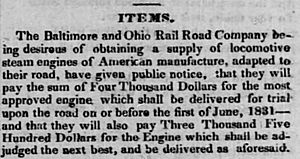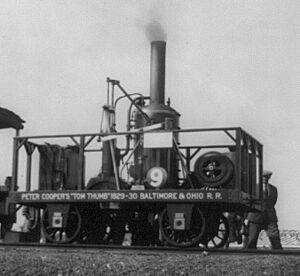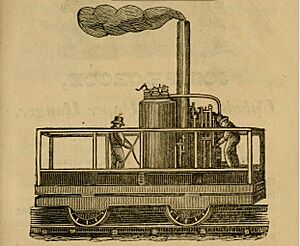Tom Thumb (locomotive) facts for kids
Quick facts for kids Tom Thumb |
|
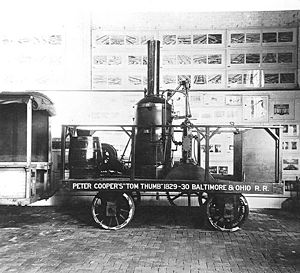 |
|
| A 1927 replica of Tom Thumb, the first American-built steam locomotive | |
| Power type | Steam |
|---|---|
| Builder | Peter Cooper |
| Build date | 1829 |
| Configuration | 0-4-0 |
| Length | 13 ft 2+3⁄4 in (4.03 m) |
| Height | 12 ft 9 in (3.89 m) |
| Fuel type | anthracite coal |
| Boiler | 27 in × 66 in (690 mm × 1,680 mm) dia × high |
| Cylinder size | 5 in × 27 in (127 mm × 686 mm) dia × stroke |
| Power output | 1.4 hp (1.0 kW) horsepower |
Tom Thumb was a very important steam locomotive. It was the first steam engine built in America to run on a public railroad. A public railroad is one that carries both people and goods. Peter Cooper designed and built it in 1829.
Cooper wanted to show the owners of the new Baltimore and Ohio Railroad (B&O) that steam engines were better than horses. Tom Thumb was not meant to carry passengers or cargo for money. It was just for showing off what steam power could do.
This little engine is famous for a race it had with a horse-drawn car. The horse won because Tom Thumb had a small problem. But even so, the demonstration was a big success! The railroad decided to use steam engines. They held contests the next year to find the best working engine.
Contents
The Start of Railroads
Why Steam Engines Were Needed
Early railroads were simple tracks on roads. Horses pulled wagons and carriages that had special wheels for the rails. Trains could not move by steam power until the steam engine could be put onto wheels.
The very first steam locomotives were built in England. This is where steam power was invented. The first locomotives in America were brought over from England. But soon, Americans started planning to build their own steam engines.
Building Tom Thumb
Who Designed Tom Thumb?
Peter Cooper designed Tom Thumb. It was a four-wheel locomotive. It had a tall, upright boiler and cylinders that were also mounted straight up. These cylinders helped power the wheels on one of the axles.
How Was It Built?
Tom Thumb was built using many clever ideas. For example, the boiler tubes were made from old rifle barrels! A special fan, called a blower, was placed in the chimney. This blower was run by a belt connected to the powered axle. The engine used anthracite coal for fuel.
Cooper had invested a lot of money in land near Baltimore. He hoped that a successful railroad would make his land more valuable. The engine was built in the machine shop of George W. Johnson. A young apprentice named James Millholland helped build it. Millholland later became a famous locomotive designer himself.
The Famous Race
Where Did the Race Happen?
Tom Thumb was tested on the first part of the B&O railroad line. This section connected Baltimore to Ellicott Mills (now Ellicott City, Maryland). At first, horses pulled the cars on this track.
There were two tracks built. This led to a challenge from Stockton and Company. They ran a stagecoach line and offered passenger and freight service. They challenged Tom Thumb to a race!
Horse Versus Machine
The race was about 8 miles long, from the Relay House to Baltimore. It might have happened on August 28, 1830. Some sources also say August 25 or September 28.
Tom Thumb easily pulled ahead of the horse at the start. But then, the belt that ran the blower slipped off! Without the blower, the boiler could not make enough steam. The locomotive lost power, and the horse passed it to win the race.
Even though the horse won, everyone saw that the steam engine was much better. It could pull more and go faster. The B&O railroad stopped using horses in 1831.
What Happened Next?
The Legacy of Tom Thumb
Tom Thumb was not built to be used every day. Because of this, the original locomotive was not saved. However, Peter Cooper and others wrote down many details about it. This helped people understand what it looked like and how big it was.
In 1892, a wooden model of Tom Thumb was made by Joseph Gladding Pangborn. Later, in 1927, the B&O railroad held a big event called the "Fair of the Iron Horse". For this event, a working copy, or replica, of Tom Thumb was built.
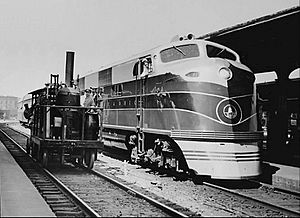
This replica was based on Pangborn's model. So, it was a bit different from the original. It was larger, heavier, and taller. For example, it had a much bigger blower on its platform. This helped it make more steam.
Today, this replica is on display at the B&O Railroad Museum in Baltimore. The museum says the replica can still run. It makes special appearances each year for visitors to see.


